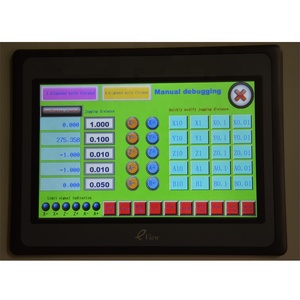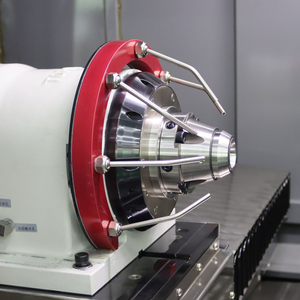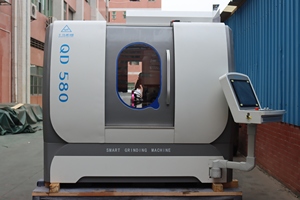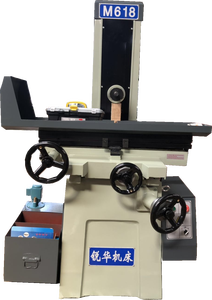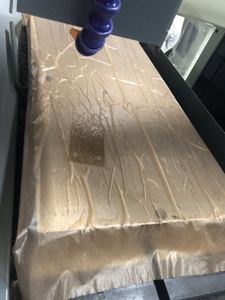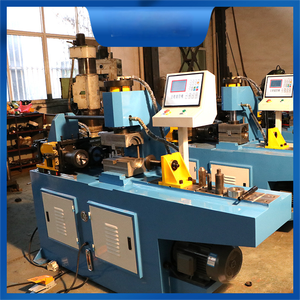Types of CNC tool grinders
A CNC tool grinder machine is used for end mills, drill bits, reamers, taper round dies, knurling dies, thread taps, milling cutters, cutting tools, etc., with complicated shapes. It can grind cutting tools from materials like HSS, carbide, and cobalt steel. The machine can perform operations like side relief, helical fluting, inner holed fluting, and back taper.
- 5-axis CNC tool grinder: This is a standard configuration for most CNC tool grinders. A 5-axis CNC tool grinder generally has five working axes, which are usually the main spindle axis and four additional rotating or sliding axes. The tools can be ground and machined freely from multiple angles and orientations by adjusting the position and angle of the workpiece through these axes. This allows for the treatment of objects of different shapes and sizes.
- 6-axis CNC tool grinder: CNC tool grinders with six axes have one additional axis compared to five-axis grinders, providing more flexibility and precision. In addition to the five axes of 5-axis grinders, the additional sixth axis may be a fixed/translation axis, which can change the position of the workpiece and the grinding head. This axis may be combined with other axes to realize more complex machining and grinding functions.
- Universal CNC tool grinder: A universal CNC tool grinder machine has a clamping mechanism to position and fix the workpiece. It is usually adjustable, which can adapt to workpieces of different sizes and shapes. The main spindle of the universal CNC tool grinder has a high-speed motor that provides the grinding power. Furthermore, the universal CNC tool grinder is equipped with a cooling system. During the grinding process, it is easy to generate heat, and the coolant can help control the temperature to avoid overheating and burning of the workpiece.
- Customized CNC tool grinders: These machines are perfect for businesses that need a specific type of grinder to fulfill their unique requirements. Whether for high-volume production lines or specialized small-batch manufacturing, personalized solutions help companies achieve greater efficiency and productivity.
- Automated CNC tool grinders: An automated CNC tool grinding machine typically includes a computer numerical control (CNC) system. The CNC system contains a programmable controller and a numerical control unit, among other things. The programmable controller can receive input signals, such as grinding parameters, tool types, etc., and then convert them into command signals for the CNC system to control the grinding machine's operation. Automation improves production efficiency and reduces the need for manual operation and intervention.
Specification and Maintenance
The specifications of a CNC tool-grinding machine may vary depending on the model and manufacturer. Some focal points of the specifications include:
- Grinding Gears: These are the different discs and cutters that a CNC tool grinder has. Various grinders have varying discs and cutters. Each disc or cutter is used to grind tools that have varying shapes and sizes.
- Power Supply: A tool CNC grinder's power supply is important as it determines the amount of power the machine uses to operate. It also influences the speed and torque of the grinder's motor. Multiple grinders have distinct power supply requirements, including voltage and current.
- Extra Attachments: For enhanced tool grinding effectiveness and precision, CNC grinders may come with additional accessories and attachments. Workholding devices, cooling systems, dust collection systems, and automatic tool changers are a few typical extras.
- Software: A CNC grinder's software influences its capacity to produce high-quality items precisely. The tools' design and control are managed by this. Certain CNC grinders feature more sophisticated software capabilities, including simulation and optimization.
For CNC tool grinder machines to serve their clients for many years, it is paramount that they are maintained properly. Some maintenance practices include:
- Regular cleaning: In order to get rid of dust, debris, and coolant residue, it is important to routinely clean the CNC grinder's surface, work area, and interior sections. This not only aids in preventing tool deterioration but also promotes the maintenance of optimal functioning levels.
- Lubrication: After regularly cleaning the CNC tool grinder, the next step is to lubricate it. Lubricating moving parts helps them last longer and enhances functioning by reducing friction and heat.
- Inspection: Conduct a frequent thorough inspection of the grinder after cleaning, lubricating, and maintaining tool holders and cutting discs. Things like electrical connections, coolant systems, and dust collection systems, among others, should be checked for loose connections, leaks, and clogs.
Scenarios of CNC tool grinder machines
The purpose of a CNC tool grinder is to grind and sharpen tools. However, this purpose could lead to many applications and uses.
Here are some ways industries and businesses use the CNC tool sharpeners:
- Cutting tools: A cutting tool could be a drill bit, metal saw, reamer, hob, milling cutter, or any tool that performs the action of cutting. All these tools come with various complexities and specifications. Some have teeth; some have abrasive edges, and others have razor-sharp blades. Regardless of the type of cutting tool, they all need to be sharp for effective use. An automated grinding machine sharpens the tools precisely and efficiently. This means that they can be restored, and their lifespans can be increased with CNC grinders. Without these machines, many cutting tools would end up being waste.
- Manufacturing industry: The manufacturing industry relies on machinist tools. These tools require grinding machines to maintain their productivity levels. The CNC machines can grind multiple tools at a time. This helps the manufacturing industry save time and maintain a steady supply of sharpened tools to be used in factories and workshops.
- Woodworking and carpentry: The woodworking industry also uses a variety of CNC machines. From saw blades to drill bits used for carpentry work, all these tools require regular sharpening to maintain accuracy and efficiency. Tool grinders ensure that woodworking and carpentry remain clean and precise cuts are made.
- Metal fabrications: Similar to woodworking, metal fabrication also makes use of a variety of tools, including drill bits and bladed saws. A metal CNC tool grinder sharpens tools used for metalwork to ensure clean cuts and precision work. It can even handle more complex cutting tools likeCountersinks, coping saws, thread taps, andReamers.
- Automotive and Aerospace Repair: The automotive and aerospace industries also utilize CNC tool grinders to maintain their cutting tools. When manufacturing vehicles and planes, precision is essential, which can only be achieved with sharp cutting tools. Automotive and aerospace industries may need specialized tool grinders for complex shapes and sizes that are unique to this industry.
- Medical Device Production: The tools used to create medical devices must be sharp, as the industry demands high-quality products with precision. A CNC tool grinder can help restore these tools quickly to meet production schedules.
- Prototype Development: CNC tool grinders can also be used during rapid prototyping. When creating models and prototypes to test new ideas and develop new products, manufacturers will need grinders to maintain their cutting tools. A CNC tool grinder machine makes it easy to create and test models quickly.
How to choose CNC tool grinder machines
Normally, people select grinders based on the type of tools they will use them on. Here's a list of things one may want to consider before purchasing a tool grinder.
- Compatible tools: Before buying a CNC tool grinding machine and its accessories, one needs to make a list of the tools they'll want to use with the device. They should prioritize their needs and research machines that can support those tools. Focus on the grinders with adjustable settings and attachments to accommodate a wider range of tools, as this will perfectly meet one's needs.
- Material requirement: Buying materials suited to one's work is important. However, some people may require more than others and, consequently, the machines used. Industrial professionals need to get heavy-duty machines that can handle a wide variety of tool materials. On the other hand, those working on lighter materials at a low intensity will do just well with low-heavy-duty machines.
- Grinder type: There are various types of tool grinders, each designed for specific tools and grinding applications. Take, for instance, the CNC tool grinding machine with a spindle holder and collet for holding the milling cutter. A surface grinder works differently. It's important to decide what exactly needs to be ground before finalizing on the type of grinder to settle for.
- Quality requirements: When it comes to the quality of the final product after grinding, some may want more deficiencies and others less. Heavy-duty industrial machines have higher-quality output because they're designed to handle more work. People in more demanding work environments need to get higher-quality tool grinders. When buying low, it's possible to settle for a tool grinder that produces a lower-quality output.
- User's experience: A novice may want to go for a grinder with a lot of instructions on how to use it. Inexperienced users should have user-friendly interfaces, intuitive controls, and clear documentation. More experienced users know what works for them and will prioritize customization and flexibility.
- Budget: One may want to start by assessing and determining the budget one intends to spend on a tool grinder. Those with a larger budget can explore advanced CNC tool grinders with higher levels of automation and more sophisticated grinding algorithms. People with a lower budget will do just perfectly with non-CNC tool grinders.
Cnc tool grinder machine FAQ
Q1: What types of tools can a CNC tool grinder machine handle?
A1: Generally speaking, different models of CNC grinders are suitable for different materials. Some grinders are versatile and can handle various materials such as steel, carbide, high-speed steel, stainless steel, etc. Others are specialized and can only work on particular substances.
Q2: What advantages does a CNC tool grinder machine offer over manual grinding?
A2: CNC tool grinders provide many benefits, such as automation, higher precision, consistent repeatability, optimal efficiency, and lower operator skill requirements. They also improve productivity and yield rates.
Q3: Can a CNC tool grinder machine be used for sharpening cutting tools?
A3: Yes, one of the primary applications of CNC tool grinders is the sharpening of cutting tools. They can restore the original geometries of the tool edges and enhance the tools' performance, manufacturing, and maintenance efficiency.
Q4: What is the typical power consumption of a CNC tool grinder machine?
A4: The power usage of a CNC tool grinder varies according to its size, capacity, and specifications. Generally speaking, large-scale industrial-grade CNC tool grinders have a motor power of several kilowatts.




































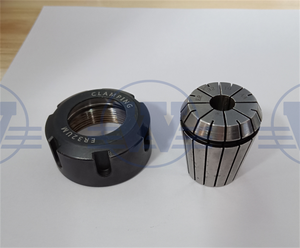












































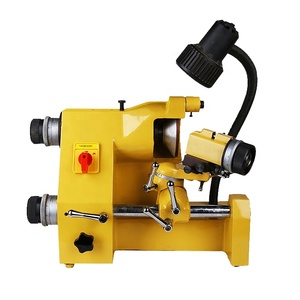



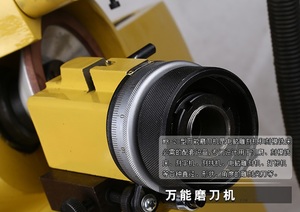




























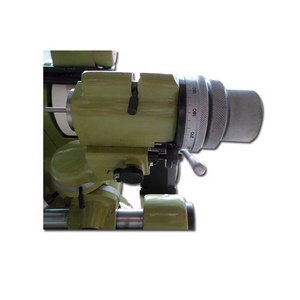


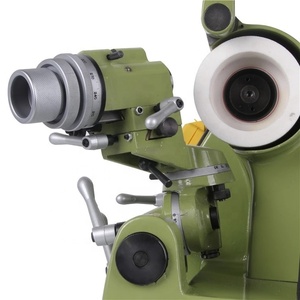
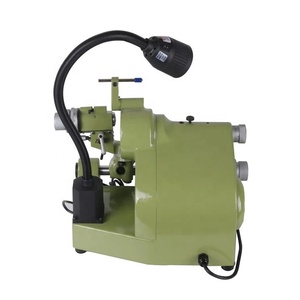






![SKDMYH-350 [450] - 5 <strong>CNC</strong> 5-axis One-sided/circular Are Integrated <strong>Tool</strong> <strong>Grinder</strong> Knife Grinding <strong>Machine</strong>](http://s.alicdn.com/@sc04/kf/H4be17b9e5b5c4efe94ebf330d656a2a4X.jpg_300x300.jpg)
![SKDMYH-350 [450] - 5 <strong>CNC</strong> 5-axis One-sided/circular Are Integrated <strong>Tool</strong> <strong>Grinder</strong> Knife Grinding <strong>Machine</strong>](http://s.alicdn.com/@sc04/kf/He380f304d5bb44acbba76db4394d7328Y.jpg_300x300.jpg)

















